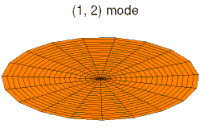
Back تحليل دالي Arabic Analís funcional AST Функциональ анализ Bashkir Функцыянальны аналіз Byelorussian Функционален анализ Bulgarian Anàlisi funcional Catalan شیکاریی فانکشنی CKB Analisi funzionale (matematiche) Corsican Funkcionální analýza Czech Функцилле анализ CV

Functional analysis is a branch of mathematical analysis, the core of which is formed by the study of vector spaces endowed with some kind of limit-related structure (for example, inner product, norm, or topology) and the linear functions defined on these spaces and suitably respecting these structures. The historical roots of functional analysis lie in the study of spaces of functions and the formulation of properties of transformations of functions such as the Fourier transform as transformations defining, for example, continuous or unitary operators between function spaces. This point of view turned out to be particularly useful for the study of differential and integral equations.
The usage of the word functional as a noun goes back to the calculus of variations, implying a function whose argument is a function. The term was first used in Hadamard's 1910 book on that subject. However, the general concept of a functional had previously been introduced in 1887 by the Italian mathematician and physicist Vito Volterra.[1][2] The theory of nonlinear functionals was continued by students of Hadamard, in particular Fréchet and Lévy. Hadamard also founded the modern school of linear functional analysis further developed by Riesz and the group of Polish mathematicians around Stefan Banach.
In modern introductory texts on functional analysis, the subject is seen as the study of vector spaces endowed with a topology, in particular infinite-dimensional spaces.[3][4] In contrast, linear algebra deals mostly with finite-dimensional spaces, and does not use topology. An important part of functional analysis is the extension of the theories of measure, integration, and probability to infinite dimensional spaces, also known as infinite dimensional analysis.
- ^ Lawvere, F. William. "Volterra's functionals and covariant cohesion of space" (PDF). acsu.buffalo.edu. Proceedings of the May 1997 Meeting in Perugia. Archived from the original (PDF) on 2003-04-07. Retrieved 2018-06-12.
- ^ Saraiva, Luís (October 2004). History of Mathematical Sciences. WORLD SCIENTIFIC. p. 195. doi:10.1142/5685. ISBN 978-93-86279-16-3.
- ^ Bowers, Adam; Kalton, Nigel J. (2014). An introductory course in functional analysis. Springer Science & Business Media. p. 1.
- ^ Kadets, Vladimir (2018). A Course in Functional Analysis and Measure Theory [КУРС ФУНКЦИОНАЛЬНОГО АНАЛИЗА]. Springer. pp. xvi.
© MMXXIII Rich X Search. We shall prevail. All rights reserved. Rich X Search